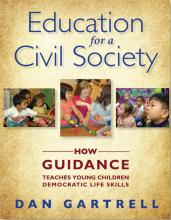Excerpt from Education for a Civil Society: How Guidance Teaches Young Children Democratic Life Skills

Building Relationships with Children: Contact Talks
Relationships are built on trust, and sustaining children’s trust is fundamental to their progression in any of the democratic life skills. Treating children with respect during interactions—including conflicts—is essential. At all times, teachers work to avoid embarrassment, shame, and humiliation to protect children’s self-image and enable them to view the classroom environment as trustworthy. A basic guidance principle is that the teacher builds relationships with children outside of conflict situations and sustains the relationship during conflicts. This is especially true with children who demonstrate challenging behavior. The fundamental practice for building relationships with children is the contact talk.
Two basic types of teacher-child discussions are task talk and contact talk. Task talk represents the necessary language of getting things done: “Let’s get the room cleaned up quickly so we have lots of time outside!” “Please open your math books to page 59.” There is plenty of task talk every day in every classroom because there are so many everyday tasks to be accomplished.
In contrast to the language of task talks, there is the language of interpersonal relationships. This language happens during contact talks. The purpose of a contact talk is to share a few moments of quality time with another human being, to learn more about the other person, and (at selected moments) to share a bit about oneself. While task talks arise naturally during the course of the day, teachers have to look for moments in which to have contact talks with children.
During the teacher’s busy day, the willingness to suspend tasks and share a moment with a child allows for a connection that lasts (Gartrell 2011). Some contact talks last only a few seconds, as in the following example.
Louie runs out the door onto the playground, does a circle around his teacher, jumps to a stop in front of her, and pulls his jeans up above his shoes. “Look, Teacher, new ones!”
Mrs. Ramirez smiles. “Your tenny-runners are white and yellow and blue. You sure can run fast in them.”
“Not tenny-runners, Mrs. R—’letic shoes,” Louie corrects her.
“I bet you can run really fast in those athletic shoes, Louie.”
“Yep, watch me!” Louie runs off.
An important time to have contact talks is when children arrive in the morning. While this is generally a busy time for teachers, the effort to arrive a bit earlier in order to have the room ready enough to greet children individually can make a difference in teachers’ relationships with children and in setting the tone for the day. Here is an example of a morning contact talk.
First grade teacher Jason notices that Jeb walks into class more slowly than usual and has his head down.
Jason: You look a bit sad today, Jeb. [He knows Jeb well enough to just say this and then listen.]
Jeb: My dog, Bumpers, got hit by a car last night.
Jason: Oh, Jeb, I am so sorry. [pauses, gives Jeb a shoulder hug and wait time]
Jeb: My mom and me took Bumpers to the vet, but she said he died quickly and didn’t feel any pain. The vet gave me his dog collar to remember him. It’s small so I’m keeping it in my pocket.
Jason: You may need to take it easy and not push yourself today, Jeb. Remember, I am here if you need me.
Jeb: [pauses for a few seconds] I know.
In emotional terms, it might seem like this contact talk took several minutes. But in actuality, it took less than two minutes and only six exchanges. Jason no doubt made Jeb’s day less difficult by his willingness to listen to Jeb and to offer support. When later that morning Jeb spilled his glue, Jason was able to take Jeb’s perspective and help the boy cope. Otherwise Jeb might have exploded in frustration—and Jason might not have understood why. Contact talks are key in supportive teaching.
Lead teacher Robin (from an anecdote in the previous chapter) wanted to have contact talks with Joe, who was showing Level Three aggression, when he arrived each day. Other staff members were reluctant to have Robin unavailable during this busy time. Robin had to get the director’s backing to have her time freed up to have the talks. But when Joe began to have fewer outbursts during the day, the team came to see the contact talks as a wise investment of Robin’s time.
As a follow-up project after a guidance workshop, a third grade teacher made a chart of every child in her class of 28, and held contact talks with five different children each day, putting a check by their names as she did. At the end of a month, she felt that she knew the children better and that the atmosphere of the room had changed. When one child, Mia, asked the teacher how her baby was doing, the teacher realized that the students were also experiencing increased understanding. The teacher had mentioned to Mia that one night she had had to take the baby to an urgent care facility. The teacher responded to Mia with a smile, “Thank you for asking. Our baby is doing much better.”
As Copple and Bredekamp state,
Close teacher-child attachments and supportive social environments are important not only for enhancing self-esteem and shaping positive self- concept but also for promoting school adjustment, academic achievement and social skills. . . . Children at risk for behavioral problems and children with developmental delays or disabilities may be especially affected by the quality of the teacher-child relationships. (2009, 265)
Contact talks are vital to creating a supportive social environment and building teacher-child attachments.
From Education for a Civil Society: How Guidance Teaches Young Children Democratic Life Skills, by D. Gartrell. Copyright © 2012 National Association for the Education of Young Children.
